|
Canon TS-E 17mm f/4 L - Analysis - max. shift (12mm) |
|
Lens Reviews -
Canon EOS (Full Format)
|
|
Page 4 of 4
 The following analysis is based on the a 12mm shift or in other words - the top end (rather than the center) of the test chart has been aligned to the lens here.
The following analysis is based on the a 12mm shift or in other words - the top end (rather than the center) of the test chart has been aligned to the lens here.
Distortion
In terms of sheer numbers there's only a marginal difference between the "shifted" (1.25%) and "conventional" (1.14%) barrel distortion. Upon closer observation you may notice that the lines at top end of the test chart are perfectly straight - remember that is actually the position to which the camera is aligned to - whereas the bottom part shows a much more pronounced barrel distortion (probably around 2% locally).
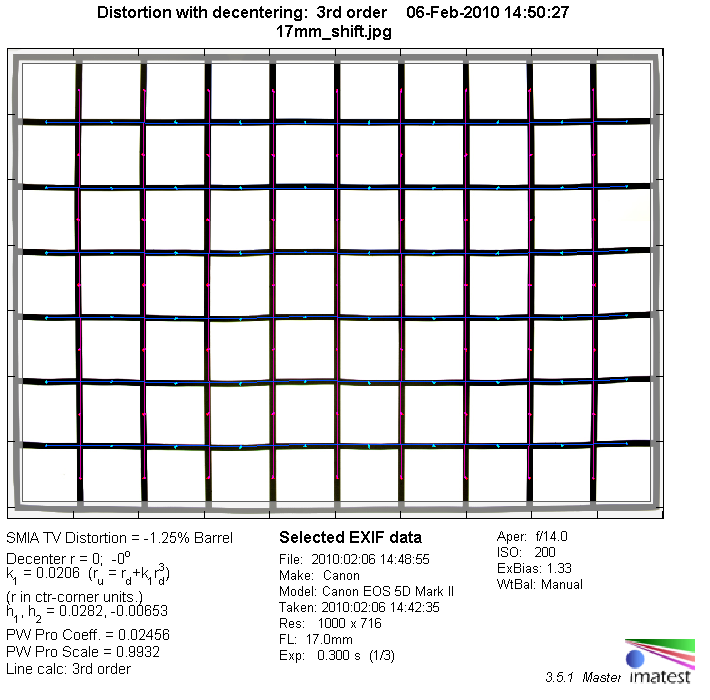
The chart above has a real-world size of about 120x80cm.
Vignetting
As mentioned the image circle is of the lens is immense (~67mm diameter vs ~43mm diameter for non-TS lenses) but if you shift the lens to the most extreme position you exploit the potential to the max of course (~43mm + 2* 12mm shift = ~67mm). The resulting vignetting characteristic is very unusual of course because side shifted to the edge of the image field receives a much worse edge shading compared to its inner counterpart. The "worst" image portion has a vignetting of more than 3EV at f/4. If possible you should stop down to f/8 where the problem is much less pronounced (~1EV).
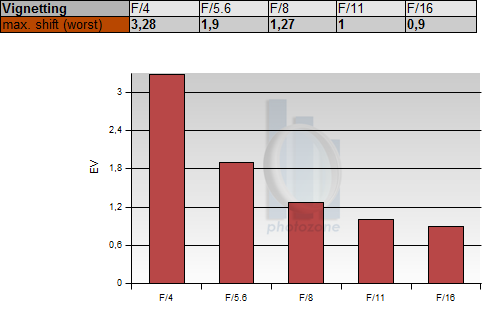
Here's a visual comparison between the "unshifted" and "max. shifted" setup at f/4:
| shift = 0mm, f/4 |
shift = 12mm, f/4 |
 |
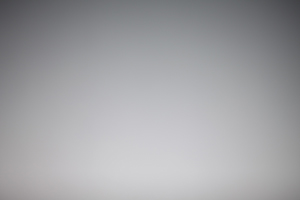 |
MTF (resolution)
(revised) The maximum shift has naturally also impact on the resolution characteristic. The image is comparatively softer at f/4 - this applies to the center as well as the "inner" borders but the "outer" corners are naturally especially affected here. The situation improves already at f/5.6 but the very good sweet spot is reached at f/8. f/16 should be avoided due to more pronounced diffraction effects.
We should clearly point out again that this is the performance based on a shift of 12mm. You can expect much better figures at less extreme shift settings. It's also worth to mention that in the outdoor conditions you tend to shoot "upwards" so the "worse" image portion is located the sky portion where it plays a less significant role.
Below is a simplified summary of the formal findings. The chart shows line widths
per picture height (LW/PH) which can be taken as a measure for sharpness.
If you want to know more about the MTF50 figures you may check out the corresponding
Imatest Explanations
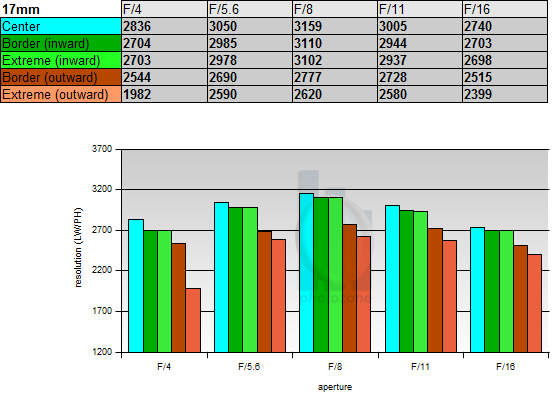
Chromatic Aberrations (CAs)
It's somewhat surprising but lateral CAs are still very well controlled even at the "outer" borders which are barely worse than in the conventional setup. Seems as if Canon did a really good job here.
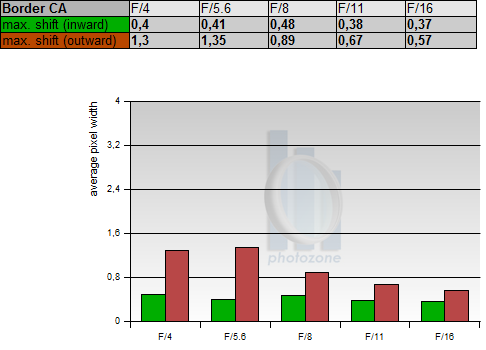
VerdictThe Canon TS-E 17mm f/4 L is an amazing lens although beginners will struggle to master its possibilities at once. When using the lens based on conventional settings it behaves pretty much like a normal ultra-wide prime lens. The center performance is pretty much excellent followed by good borders/corners at f/4. At medium aperture settings it's very sharp across the frame. The level of barrel distortions is unusually low. Same goes for the vignetting figures as well as for lateral CAs. The lens is somewhat more prone to flare due to its bulb-like front element.
The real power of the lens is unleashed when using the tilt-shift features and their corresponding capabilities in terms of perspective- and depth-of-field control. The Canon lens is like no other here - it's the only ultra-wide tilt-shift lens for conventional SLRs. The shift aspect (perspective control) doesn't come for free though. Depending on the amount of shift it increases the vignetting (single-sided) and there's a penalty in terms of resolution. Typical for tilt-shift lenses you've to live without AF and the conventional light metering tends to be off when shifting an image (Live-View behaves fine here). The build quality is absolutely stellar but then you can expect no less from a lens in this price class.
Technically there may be lenses out there which can match and perhaps even surpass the lens for conventional photography but the Canon has a creative potential which you will not find anywhere else. Consequently it's ... highly recommended!
|